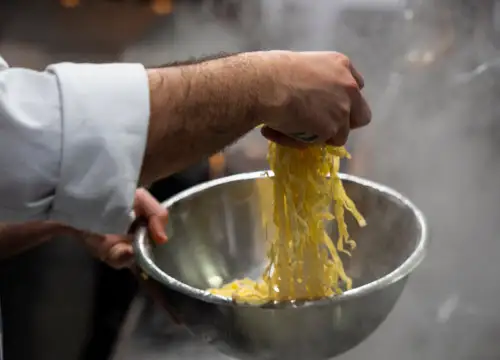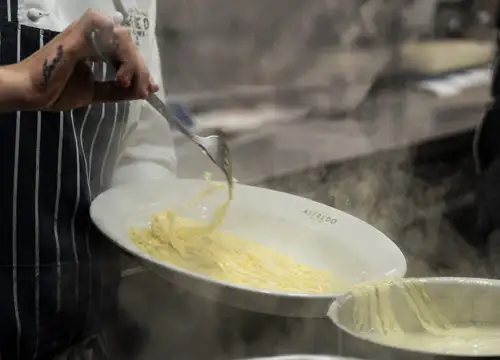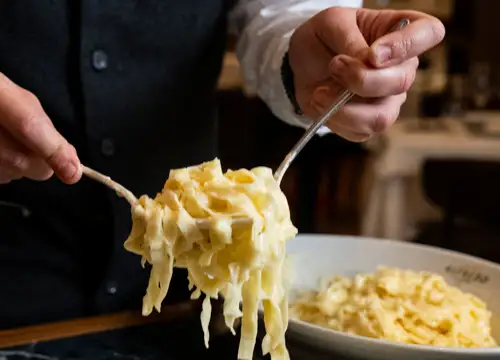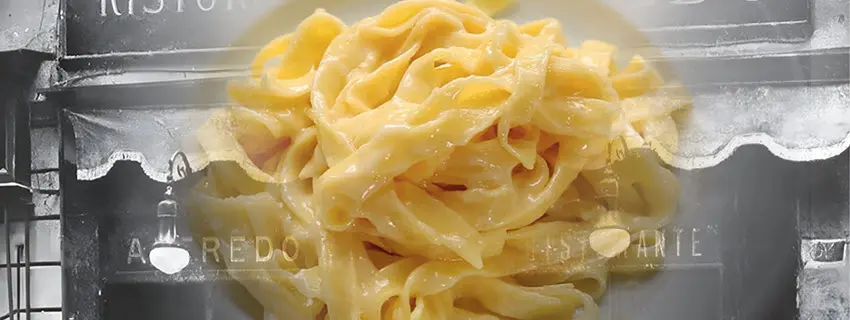Published:
Author: Antonio Maria Guerra
Fettuccine Alfredo
THE COMPLETE GUIDE TO THE ROMAN SPECIALTY

Italy is a country so rich in exquisite foods that some are little known even to Italians. This is the case, for example, of Fettuccine Alfredo: a specialty born in the Belpaese, unknown to many and often considered an invention ‘Made in USA’, when in fact it is, without doubts, ‘romana de Roma’ (‘Roman from Rome’). Let’s deepen our knowledge of this delicacy, with the precious help of one of the historic restaurants that preserve its tradition.

What is Fettuccine Alfredo?
Fettuccine Alfredo is a Roman specialty made with a special type of egg pasta, fettuccine, which, in the original version invented by chef Alfredo di Lelio, is seasoned with just two ingredients: butter and Parmigiano cheese (Parmesan). Their skillful mixing (a process known as ‘mantecatura’) produces a delicious cream that gives the dish its typical golden color. Its taste and attractive appearance have made this delicacy very popular, especially in the United States.
Origins.
Fettuccine Alfredo was born in Rome in 1908 when chef Alfredo Di Lelio invented his own version of pasta with butter and Parmesan cheese to sweeten (and nourish) his pregnant wife. Thanks to its taste and the quality of its ingredients, the dish was appreciated by some of the greatest Hollywood stars of the 1950s, who promoted it in the United States. In time, the specialty became so famous that it is still considered a classic of Italian gastronomy.
(more information)

Fettuccine Alfredo: the recipe.
It’s hard to find a recipe as simple and tasty as Fettuccine Alfredo. There is no doubt that one of its secrets lies in the superlative quality of the three ingredients (fresh egg fettuccine, butter, and Parmesan cheese), the other in the care with which it’s prepared. Once the butter has been placed on the serving dish, the pasta is added, together with a little of the water from the cooking. Everything is then enriched with a good amount of grated cheese. The last step, which is essential, is the ‘mantecatura’: the mixture is stirred with cutlery until the butter and the cheese, diluted by the water, have reached a uniform creaminess.
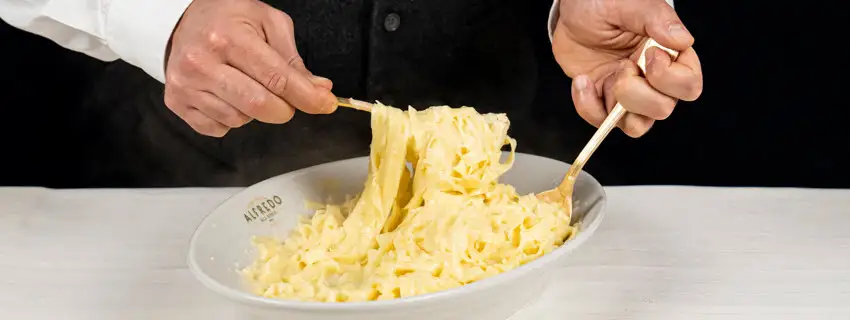
The ‘mantecatura’: Alfredo’s real secret.
Among the secrets that make a seemingly simple dish such as Fettuccine Alfredo so exquisite is undoubtedly the ‘mantecatura’. Thanks to this procedure, carried out by expert hands, butter is mixed with Parmigiano Reggiano cheese and a little cooking water to create a cream that really enhances the flavor of the pasta. Even today, in the two restaurants that are the de facto guardians of the recipe’s tradition (both mentioned in this article), this operation is carried out directly at the table by expert staff, using the same gestures that have been handed down since the days when it was Alfredo di Lelio himself who performed them with movements that were as blatant as they were fascinating.
The preparation of Fettuccine Alfredo in video.
This video, shot at the restaurant ‘Alfredo alla Scrofa’, shows the method used to prepare the original Fettuccine Alfedo. Many thanks to the YouTube channel Italia Squisita, author of the footage.
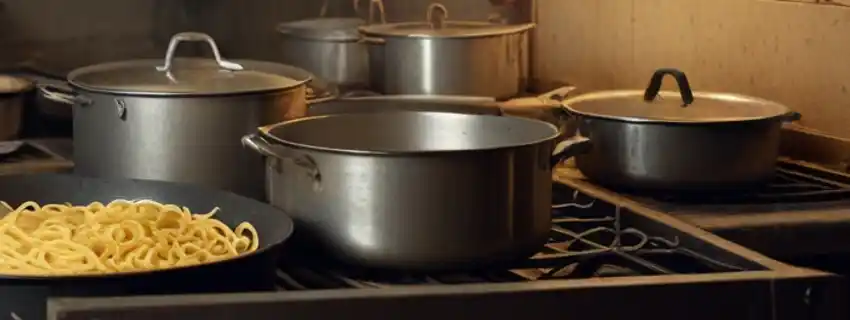

Fettuccine Alfredo: the USA recipe.
There is no doubt that the American version of Fettuccine Alfredo is a decidedly ‘daring’ interpretation of the original Roman dish, invented in 1908 by Mr. Alfredo Di Lelio. While the Italian recipe consists in ‘just’ fresh fettuccine seasoned with high-quality butter and aged Parmigiano Reggiano, in the United States the ‘basic’ version of the specialty usually includes cooking cream and parsley, or even garlic and other (fanciful) ingredients.
So, it’s possible to say that the Stars and Stripes version of Fettuccine Alfredo retains almost only the name of the original dish, largely disregarding the typical minimalism that made it so famous.

Fettuccine Alfredo: ingredients.
Despite expressing a taste that has made them famous, the original Fettuccine Alfredo is, at least in appearance, a very simple dish, prepared with only three ingredients, namely:
Fresh Fettuccine;
Butter;
Parmesan cheese;
Read more
The key to its perfection is the very high quality of the products used and the particular way it is prepared: a real art that sets it apart from the common ‘pasta al burro’ (pasta with butter).
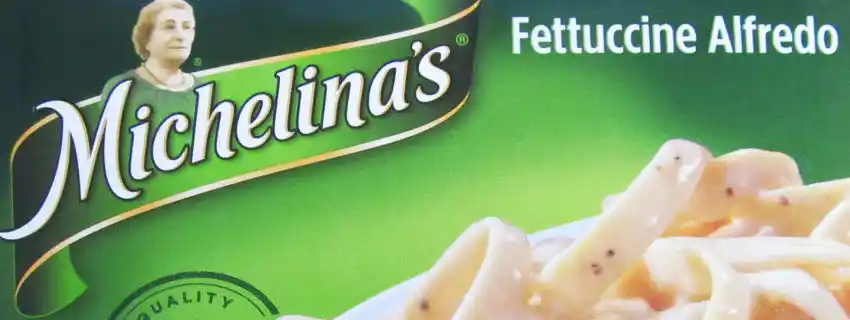
Fettuccine Alfredo: variations.
Much has changed since the days when Fettuccine Alfredo was introduced in the United States thanks to the film stars who fell in love with it in the fifties, partly for taste and partly for fashion. Nowadays, on the other side of the Atlantic, the recipe for this specialty is often twisted, giving rise to many ‘daring’ versions: the most popular is, without doubt, the ‘Chicken Alfredo’, made with chicken meat. Other widespread variations include ingredients such as, for example, prawns, broccoli, mushrooms, peas, many types of cheese (in addition to Parmesan), or even bacon.

Parmigiano: seasoning and characteristics.
The contribution of Parmigiano Reggiano, one of Italy’s most celebrated cheeses, is of fundamental importance to the success of Fettuccine Alfredo. Thanks to its high quality, this cheese can give the dish a perfect balance between savouriness and sweetness. Available in different maturations, the 24-month one undoubtedly has the texture and aromaticity best suited to combining with melted butter to create the delicious cream that has makes the specialty so famous.
(more information)
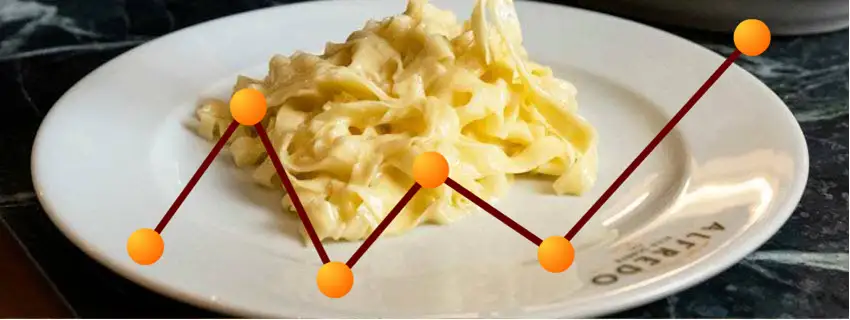
Fettuccine Alfredo: calories and nutritional values.
A 100 g portion of Fettuccine Alfredo provides an average of between 250 and 350 calories. These come, in order, from the carbohydrates in the pasta and the fats (mainly saturated) in the butter, which make the dish particularly rich. There is also a fair amount of protein and minerals, mainly from the Parmesan cheese. Finally, this dish is very rich in calcium and vitamins A, B, and B12.

Fettuccine Alfredo: best pairings.
To find some of the best wines to accompany a dish of fettuccine Alfredo, you don’t have to go far from Lazio, the birthplace of the specialty. In fact, the vineyards of this part of Italy produce two extremely pleasant whites: Frascati DOC and Est! Est!!! Est!!! From Montefiascone. According to the Italian Association of Sommeliers (AIS), thanks to their acidity (which can balance the inherent fatness of the preparation) and delicate fruity notes they are perfect to enhance the characteristics of the famous dish. If you prefer red wine, you can choose a Cesanese Di Affile DOC, whose soft tannins, discreet acidity, and delicate fruity notes are perfectly suited to the dish without overpowering its flavor.

Alfredo alla Scrofa: the birthplace of Fettuccine Alfredo.
This article was realised in collaboration with ‘Alfredo alla Scrofa’: the restaurant, founded by Alfredo di Lelio, which was, in fact, the birthplace of Fettuccine Alfredo.
Here are its contact details:
Contact details
Address: Via della Scrofa, 104/a, 00186 Rome (Italy)
Website: alfredoallascrofa.com
Mail: info@alfredoallascrofa.com
Tel.: +39 06 6880 6163
Copyright information.
The images displayed in this page belong to WebFoodCulture, with the exception of:
Pubblic Domain Images
- Libro De Arte Coquinaria (1450), US Library of Congress.
- Restaurant ‘Alfredo alla Scrofa’, entrance By Google Maps.
Creative Commons Images
- “Fettuccine” by TheGirlsNY is licensed under CC BY-SA 2.0.
- “PEOPLE – Male – Burt Lancaster – 1947 – Desert Fury” by monstersforsale is licensed under Public Domain Mark 1.0.
- “Jack Lemmon” by classic film scans, is licensed under CC BY 2.0.
- “12-13-1951_10109 Frank Sinatra en Ava Gardner” by IISG is licensed under CC BY-SA 2.0.
- “Mary Pickford and Douglas Fairbanks” by classic film scans is licensed under CC BY 2.0.
- “Rome” by Nick Kenrick.. is licensed under CC BY 2.0.
- “Mary Pickford and Douglas Fairbanks” by classic film scans is licensed under CC BY 2.0.
- “Cerasuolo agronika” by Yozh is licensed under CC BY-SA 4.0.

